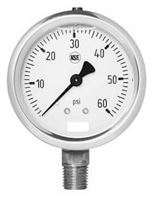What Is The Pressure Gauge?
The Pressure Gauge is a measuring instrument that helps to measure the force exerted by the fluids (liquids and gases both are called fluids) when they are in a static position and even at a dynamic position. The pressure is a type of force that we calculate when it is applied over any fluids (liquid or gases).

Types of Pressure:
We observe different types of pressures around us that need deep knowledge. So, the types of pressures are as follows:
Vacuum Pressure:
The pressure is the type of pressure that can be observed when there is no air presence. It is also called the Negative Gauge.
Atmospheric Pressure:
The normal force of the air that we can observe in the atmosphere is called Atmospheric Pressure.

Gauge Pressure:
The force of the fluids while static or dynamic that we measure using the Gauge is called Gauge Pressure. In the gauge pressure, we take atmospheric pressure as Datum. It is also called Positive Pressure.
Absolute Pressure:
The force that we can observe above the absolute zero pressure is called Absolute Pressure.
Types Of Pressure Gauge:
There are different types of pressure gauge are available according to their internal mechanism and working. Their usage and applications depend upon the industry and situation. So, a few types of pressure gauge that we can observe around us are
- Aneroid Type of Pressure Gauges:
- Bourdon Tube Type
- Bellow Type
- Diaphragm Type
- Magnetic Coupling Type
- Mcleod Gauge
- Spinning – Rotor Gauge
Read – Bourdon Tube Pressure Gauge, Its Parts, Working, Advantages, Applications, and More
Working Principle Of Pressure Gauge:
The pressure is defined as the ratio of the Force that exhibits over any fluid to the unit area. The force is measured in terms of Newtons and denoted by “N”, the area is measured in terms of meters and denoted by m2 (square meter). So, the unit of pressure is N/m2 (pronounce as Newton per square meter).

The pressure gauge is simple in construction and sensitive in nature. It is installed in the path of fluid flows or fixed to the storage tanks. If it is fixed in the path of fluid flow, then the fluid will touch the gauge and responses will be shown over the display with the help of an indicator. If it is fixed to the fluid storage tank, then the fluid is allowed to move against it, then due to its mechanism, the gauge will respond and shows the value.

The pressure can be observed in terms of N/m2 or MPa (pronounce as Mega Pascal) or even in Psi
Advantages Of Pressure Gauge:
The advantages of the pressure gauge are
- It is simple in construction and can be used at every application of fluids.
- It is easy to operate and no risk involved in the installation.
- It does not require any Power and Electricity for its work.
- The response of the gauge while measuring is fast and quick.
- The requirement of any operator or human involvement is not necessary is an additional advantage of pressure gauge.
- As the pressure is analog type, it is easy to find the pressure of any fluid.
- In few applications, the fluids will be dynamic and result in vibration of components whereas; even at vibrations, it will be accurate and no false data will be observed.
Applications Of Pressure Gauge:
The applications of pressure gauge are wide and can observe in our daily life too. A few applications are
- It is used to measure the fluid’s behavior in Industries and Companies.
- Applications of Pressure gauge are vastly used in storage tanks.
- It is used in Boilers to check and inspect the pressures of fluids.
- It is used in Air-Stations for inspecting the air volume in Tyres.
- A pressure Gauge is used to check the temperature variations too.
Conclusion:
It is all about measuring the fluids in different situations; it is nothing but the finding out of the behavior of the fluids at static and dynamic conditions. As the pressure gauge is a precision instrument, it is used in a vast range. We do even find those applications in our regular life. The various types of pressure gauge can be observed according to the applications. The internal mechanism varies in the types of pressure gauge.